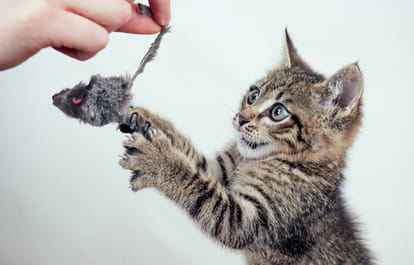
- Keep the cats separated and reintroduce them slowly
- Use play and affection, so they don’t get bored. Also, to use up their energy.
- Have three litter trays for two cats, same with food, water, and so on.
Break up any fights slowly, don’t punish the cats, and never let them ‘fight it out.’
I know how difficult it is when your younger cat is bullying your older cat. The spats and fights are so stressful not only for them, but for us. Luckily, I was able to solve this problem and today, my cats all tolerate each other well.
That wasn’t the case in 2014. In the midst of a particularly brutal winter, my family worried for the stray cat that we’d been feeding, and so we brought her inside. As it turned out, she was pregnant. She was also an absolute bully to our older cats—and in time, she would teach her children to behave the same.
This guide will show you how to stop your cats from bullying one another.
You Have Introduced Your Cats Too Quickly

When it comes to any behavioral issue, the first step is to find the root of the problem. In most cases, you’ve introduced your cats too quickly.
Most cat experts agree that you should introduce cats slowly to avoid territorial issues. We’ll dig into what this means later on, but you should begin with the cats completely separated from one another.
This is especially true when bringing home an unvetted cat. You should always take your new cat to the veterinarian and test them for illnesses like FIV (Feline Immunodeficiency Virus) and FeLV (Feline Leukemia Virus).
These are both contagious diseases that you don’t want your cat to catch. Cats with FIV or FeLV should be isolated from other cats, or live with cats who have the same illness.
You should also ensure both cats are spayed or neutered, as this will help with territorial behavior—especially in males.
Your Cat is Bored

Your younger cat may also be bullying your older cat out of boredom. It’s common for younger cats to pester older cats, as they have very different energy levels.
If this is the case, you need to play with your cats more often. Make sure they’re getting all their energy out so that they aren’t using it to get themselves into trouble!
How Do You Stop Your Younger Cat From Bullying Your Older Cat?
Now that you’ve nailed down the cause of the bullying, let’s find a solution.
1.Do Not Punish Your Cat
It seems tempting to grab a spray bottle to break up a small spat, or scream and chase your younger cat away. I’ve been there!
But it isn’t effective. Cats oftentimes don’t understand that they’re being punished—only that you’re being cruel.
Constantly punishing your younger cat will do nothing but make them afraid of you.
2. Do Not Allow Cats to “Fight It out” or Hurt One Another
You can’t rely on cats to work out their problems on their own. They’re animals, and without interference, they can and will seriously harm or even kill one another.
Whenever possible, catch the situation before it gets out of hand. If your younger cat is chasing your older one through the house, or the older cat appears fearful, this is the time to address it—even if there aren’t any serious injuries yet.
3. Break Your Cats Apart Calmly
Stay as calm as possible when breaking up your cats. It might be that all it takes is a firm “no” from you, or a stomp of your foot to spook them away from one another.
If the fighting is severe and either cat is at risk of injury, make a loud noise, use a spray bottle, or do whatever you need to get them apart. While constant punishment isn’t advisable, emergency situations are much different.
Once the cats are apart, place them in separate rooms or sections of your home. Treat their injuries, if they have any, but don’t pay further attention to your younger cat. Don’t yell at or punish them, and don’t try to calm them down. Just let them cool off on their own.
4. Keep Your Cats Separated
Your cats are going to have to stay in separate rooms for a while—possibly for months or longer. I’ve done this multiple times when introducing new cats to the home, and I know it isn’t fun for anyone involved. But it is necessary.
Keep a closed-door between your cats at all times. During this time, you can get them used to each other’s scents in various ways.
The biggest way to exchange scents is swapping territory. Depending on your situation, you might give each cat the run of the house part of the day, while the other is locked in a bedroom. If you have a larger house, you might split the house into halves.
It’s important that the cats get to explore where the other has been. This way, they can get used to their smell being around before they have to actually put up with one another!
You can also take a blanket, bed, or even an old t-shirt with a cat’s scent on it, and set it in the other cat’s area. This is another safe way to get them used to one another without having to interact.
Lastly, feed both cats by the door that separates them. They will be able to hear and smell the cat on the other side of the door, and associate them with the positive experience of eating dinner. This is much better than the negative experience of being chased or scratched.
5. Reintroduce Them Slowly
Once your cats are used to each other’s scent, you can begin to slowly reintroduce them.
Do this by letting them see one another from a distance. They shouldn’t be able to interact at this time.
If you have a glass door in your home, this one is easy! Simply keep one cat on either side. Alternatively, keep your younger cat on a harness and leash and allow your older cat into the area.
Keep these sessions where your cats can see one another short at first, and attempt to end before any hissing or attempts at fighting occur. Keep each interaction as positive as possible.
Take this process slowly, and don’t be afraid to move backwards if things go wrong. Patience really is key here.
Once your cats can routinely see one another without negative reactions, you can move onto the next step by letting them have supervised visits with one another.
Never force your cats into each other’s space, though. Remember that they don’t have to be best friends, or cuddle every morning. They don’t even have to like each other!
Some cats simply coexist in the same home and tolerate each other. That is completely okay.
6. Give Both Cats Plenty of Affection and Play Time

Neither cat should feel left out or jealous of the other. By giving them each plenty of affection, you lessen the risk of them feeling this way and lashing out.
Perhaps more importantly, your cats should not be bored. This is when they get themselves into major trouble!
At a minimum, you should play with your cats at least 30 minutes a day. It’s best to break this time into 10-15 minute intervals.
We like to think that cats are completely independent, but that’s not true. They still have basic needs that we must meet in order for them to thrive.
7. Provide Ample Resources
Each of your cats should have their own space to eat, drink, use the litter box, and feel safe.
Keep their food and water bowls on opposite sides of the room from one another. Also give them plenty of places to perch such as windowsills, cat trees, or even the back of the couch.
When it comes to litterboxes, you should have one litter box per cat, plus one extra. Two cats need three litterboxes, three cats need four litterboxes, and so on.
This all helps to lower competition for resources, and will make your cats feel less territorial overall.

I am a freelance writer who specializes in the pet industry. My full bio
Sources
- https://www.jacksongalaxy.com/blog/the-dos-and-donts-of-introducing-cats/
- https://www.vet.cornell.edu/departments-centers-and-institutes/cornell-feline-health-center/health-information/feline-health-topics/feline-immunodeficiency-virus
- https://www.vet.cornell.edu/departments-centers-and-institutes/cornell-feline-health-center/health-information/feline-health-topics/feline-leukemia-virus
- https://www.petmd.com/cat/wellness/evr_ct_exercising_with_your_cat_a_how_to_guide
- https://www.purina.com/articles/cat/litter/how-many-litter-boxes-per-cat